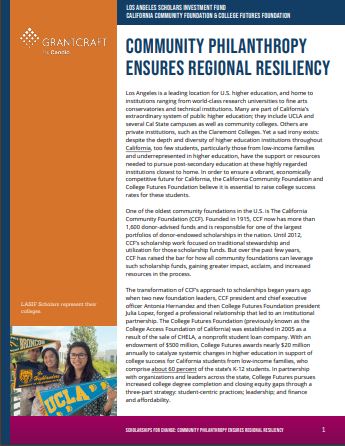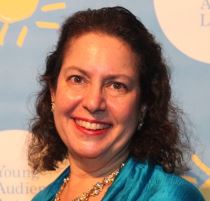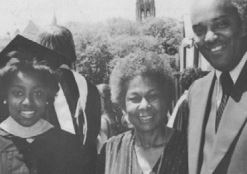Community Philanthropy Ensures Regional Resiliency
Los Angeles is a leading location for U.S. higher education, and home to institutions ranging from world-class research universities to fine arts conservatories and technical institutions. Many are part of California’s extraordinary system of public higher education; they include UCLA and several Cal State campuses as well as community colleges. Others are private institutions, such as the Claremont Colleges. Yet a sad irony exists: despite the depth and diversity of higher education institutions throughout California, too few students, particularly those from low-income families and underrepresented in higher education, have the support or resources needed to pursue post-secondary education at these highly regarded institutions closest to home. In order to ensure a vibrant, economically competitive future for California, the California Community Foundation and College Futures Foundation believe it is essential to raise college success rates for these students.
One of the oldest community foundations in the U.S. is The California Community Foundation (CCF). Founded in 1915, CCF now has more than 1,600 donor-advised funds and is responsible for one of the largest portfolios of donor-endowed scholarships in the nation. Until 2012, CCF’s scholarship work focused on traditional stewardship and utilization for those scholarship funds. But over the past few years, CCF has raised the bar for how all community foundations can leverage such scholarship funds, gaining greater impact, acclaim, and increased resources in the process.
 The transformation of CCF’s approach to scholarships began years ago when two new foundation leaders, CCF president and chief executive officer Antonia Hernandez and then College Futures Foundation president Julia Lopez, forged a professional relationship that led to an institutional partnership. The College Futures Foundation (previously known as the College Access Foundation of California) was established in 2005 as a result of the sale of CHELA, a nonprofit student loan company. With an endowment of $500 million, College Futures awards nearly $20 million annually to catalyze systemic changes in higher education in support of college success for California students from low-income families, who comprise about 60 percent of the state’s K-12 students. In partnership with organizations and leaders across the state, College Futures pursues increased college degree completion and closing equity gaps through a three-part strategy: student-centric practices; leadership; and finance and affordability.
The transformation of CCF’s approach to scholarships began years ago when two new foundation leaders, CCF president and chief executive officer Antonia Hernandez and then College Futures Foundation president Julia Lopez, forged a professional relationship that led to an institutional partnership. The College Futures Foundation (previously known as the College Access Foundation of California) was established in 2005 as a result of the sale of CHELA, a nonprofit student loan company. With an endowment of $500 million, College Futures awards nearly $20 million annually to catalyze systemic changes in higher education in support of college success for California students from low-income families, who comprise about 60 percent of the state’s K-12 students. In partnership with organizations and leaders across the state, College Futures pursues increased college degree completion and closing equity gaps through a three-part strategy: student-centric practices; leadership; and finance and affordability.
Hernandez and Lopez conceived an ambitious philanthropic initiative that would leverage the financial and knowledge resources of the College Futures Foundation while enabling the California Community Foundation to achieve greater impact with its scholarship resources. Such a partnership was created to enable Los Angeles students from low-income families or students from groups that are underrepresented in higher education to not only access local higher education institutions, but also to complete their degrees. To strive toward this game-changing goal as institutional partners, they created the Los Angeles Scholars Investment Fund (LASIF) in 2012. Recognizing historic and continued disparities in access to postsecondary degrees, Joanna Saracino of College Futures stated that their shared vision was “a thriving California through greater postsecondary education success.”
Three strategies would be deployed through LASIF:
- First, build regional education planning capacity by connecting the local stakeholders in structured processes and relationships.
- Second, improve pipeline “throughput” of regional high schools to colleges by increasing graduation rates and creating more effective post-secondary education pathways.
- Third, align policy and practice for student success by removing barriers, facilitating data-driven decision-making, improving institutional performance, and reallocating resources.
CCF’s Kelly King acknowledged that even their large portfolio of scholarship funds was “a drop in the bucket” relative to identified student need for 120,000 Los Angeles high school seniors each year, but as a community foundation, they had local knowledge and access to expertise—both essential factors in leveraging its scholarship capacity to drive larger-scale impact and change.
Mutual Fund Model
LASIF is “part high-performing mutual fund, part innovation incubator,” and partners with nonprofit organizations to provide scholarships and services that get students to and through college. By establishing LASIF, CCF was able to bring together separate unrestricted scholarship funds as a pool of scholarship resources, and restricted funds as aligned resources. While some CCF scholarship funds had restrictions reflecting specific donor intent, such as support for students pursuing a specific major, others were defined in more flexible terms.
LASIF became the prototype for the Community Philanthropy for Student Success initiative, a College Futures effort to improve outcomes for students from low-income families in various regions across California. Through this initiative, CCF and other community foundation partners have strengthened their roles as local leaders in promoting college completion; provided scholarship and other forms of support; and encouraged new donors to fund need-based scholarships. As their strategic funding and knowledge partner, College Futures provides grant support to CCF and other California community foundations to increase need-based scholarships and program staff capacity; technical assistance, such as guidance on how to build robust data systems; and research and evaluation to help track progress, measure impact, and address areas needing improvement. As local capacity is increased and college-going and completion rates of students improve, College Futures and its California community foundation partners co-determine their next measurable objectives and methods for achieving them.
Selected LASIF Scholars receive a minimum of $500 per year, and a maximum of $5,000 per year to pursue either an associate or bachelor’s degree at an accredited two- or four-year postsecondary institution in the United States; the scholarships cannot be used to reduce or replace any public or institutional aid. Saracino explains that the LASIF scholarship serves only as a part of what is required for college success: “Our scholarships are intended to be structured as incentives, as part of a comprehensive college advising strategy to increase college attainment for students from low-income families or students from groups that are underrepresented in higher education.” Even the LASIF title emphasizes Scholars, not scholarships, as the program’s focus is centered on the success of each and every student through the pairing of financial resources with essential services like college application assistance and long-term mentorship.
Scholar Spotlight
Local nonprofit organizations, familiar entities to the students and their families, become a friendly “front door” to college. One such student was San Gabriel Valley student Jeffrey Castro, who was supported by LASIF partner Upward Bound, starting in 10th grade, soon after his father passed away, leaving his mother a widow with three sons. Upward Bound provided Jeffrey with comprehensive college preparation services, including academic, financial aid, and college application assistance—they even brought him to college campuses to visit. With strong preparation from Upward Bound, Jeffrey headed to Pasadena City College, a two-year institution, with ambitions of eventually transferring to a four-year institution. To help others, he’s now working for Upward Bound between classes. As Jeffrey said in a CCF profile, “This program takes you beyond your house, beyond your neighborhood. The most important thing is the potential it unlocks in you.”
Community-Based
The sophisticated infrastructure of LASIF is largely invisible to the Los Angeles high school student who aspires to attend college but lacks the necessary financial resources or support. Through LASIF, CCF has assembled a diverse set of community-based nonprofit organizations that have histories of improving college access and success for underrepresented students. They include organizations working exclusively on this purpose, such as the Southern California College Access Network or Project GRAD Los Angeles, and other comprehensive youth-serving entities, such as Big Brothers Big Sisters of Greater Los Angeles and the Boys & Girls Clubs of the Los Angeles Harbor. Organizations that serve specific populations, such as Walking Shield, which serves Native American families, are also included in the roster of LASIF nonprofit partners.
The LASIF nonprofit partners are not simply funding conduits. These nonprofit organizations agree to participate in a collective data system, share best practices, and contribute in other ways to ensure student success and program effectiveness. They are expected to provide, either directly or through referral, pre-enrollment services such as academic preparation, college application and selection guidance, and financial counseling, and post-enrollment services including academic advising, interventions to strengthen social engagement, and continued financial counsel.
Collective Impact
To date, LASIF has achieved impressive results for its Scholars, and is rapidly growing its impact in the Los Angeles region. One telling success statistic: 90 percent of the inaugural class of 2013 persisted to their fourth year of college. In just five years, LASIF has granted $22.5 million, and served more than 35,000 students. So far, nearly 7,000 scholarships have been awarded to students from 158 high schools in the region; 91 percent are first-generation college students. Consistent with the region’s diverse population, the reported demographics for the LASIF Scholars show students who are 75 percent Hispanic or Latino, 9 percent Asian, and 4 percent American Indian or Alaskan Native.
Instead of disconnected, isolated scholarship efforts, LASIF has created a unified vehicle for achieving what has become known in philanthropy as collective impact. The CCF donors, community nonprofit partners, and higher education institutions are now coordinated and supported in their common goal to drive college success for low-income Los Angeles students.

Given the greater percentage of women (66 percent) than men (34 percent) among the LASIF Scholars—as is consistent with the national pattern of enrollment for women in higher education—LASIF launched a new initiative in 2017 to address this gender disparity. A two-year, $2 million “learning process” is now focused on Young Men of Color and is designed as an action-oriented set of projects for an inaugural cohort. Current and new LASIF nonprofit partners are engaged in this targeted effort to improve outcomes for this underserved Los Angeles youth population.
Scaling Success
According to CCF’s King, LASIF is not considered “a time-bound initiative— we now have a new mode of operating.” She and other LASIF leaders are committed to “staying on the cutting edge” of ensuring college completion for students from low-income families. To achieve even greater impact, they are adding new program components, such as the Young Men of Color initiative, which addresses the underrepresentation of young men of color among both college preparation and scholarships programs and higher education more broadly, and the RUSH Fund, a new emergency grants pilot to provide one-time funds to offset unexpected student expenses, such as car repairs or medical care. She also reported that the LASIF experience has influenced other funders, donors, and organizations in the region, especially regarding the relative impact of merit-based vs. need-based scholarships. “We’ve all done a lot of soul-searching. We’re all thinking differently about scholarships,” said King.
Given LASIF’s strong and growing results, College Futures has been able to replicate core elements of the model in partnerships formed with six other community foundations across California. But how can they scale effectively across an entire state? A regional approach to scaling is necessary since most students enroll in a college within 50 miles of their home, whether because of financial, familial, or other personal reasons, and often start at community colleges. Based on the lessons of LASIF and other regional partnerships, Saracino sees how California community foundations are uniquely positioned to “marry donor intent and needs on the ground” in ways that will transform the lives of countless Californians.
As proud alumni of California colleges and universities, LASIF Scholars are likely to remain in the regions that supported them as they pursue their California college dreams, contribute to the cultural and economic vibrancy of the state, and perhaps eventually become LASIF donors, too.
Learn more about California Community Foundation at calfund.org and College Futures Foundation at collegefutures.org
This case study is one of 12 in a suite of case studies focused on how donors are supporting scholarships to create change. The case studies have been developed in companionship with Candid’s project Scholarships for Change, a dynamic hub that pulls together data and knowledge to tell the story of how philanthropic dollars are supporting transformative scholarships.





